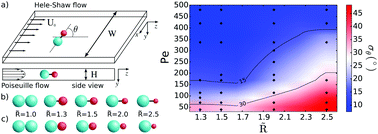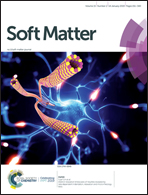Small asymmetric Brownian objects self-align in nanofluidic channels
Abstract
Although the self-alignment of asymmetric macro-sized objects of a few tens of microns in size have been studied extensively in experiments and theory, access to much smaller length scales is still hindered by technical challenges. We combine molecular dynamics and stochastic rotation dynamics techniques to investigate the self-orientation phenomenon at different length scales, ranging from the micron to the nano scale by progressively increasing the relative strength of diffusion over convection. To this end, we model an asymmetric dumbbell particle in Hele-Shaw flow and explore a wide range of Péclet numbers (Pe) and different particle shapes, as characterized by the size ratio of the two dumbbell spheres (![[R with combining tilde]](https://www.rsc.org/images/entities/i_char_0052_0303.gif) ). By independently varying these two parameters we analyse the process of self-orientation and characterize the alignment of the dumbbell with the direction of the fluid flow. We identify three different regimes of strong, weak and no alignment and we map out a state diagram in Pe versus
). By independently varying these two parameters we analyse the process of self-orientation and characterize the alignment of the dumbbell with the direction of the fluid flow. We identify three different regimes of strong, weak and no alignment and we map out a state diagram in Pe versus ![[R with combining tilde]](https://www.rsc.org/images/entities/char_0052_0303.gif) plane. Based on these results, we estimate dimensional length scales and flow rates for which these findings would be applicable in experiments. Finally, we find that the characteristic reorientation time of the dumbbell is a monotonically decreasing function of the dumbbell anisotropy.
plane. Based on these results, we estimate dimensional length scales and flow rates for which these findings would be applicable in experiments. Finally, we find that the characteristic reorientation time of the dumbbell is a monotonically decreasing function of the dumbbell anisotropy.



 Please wait while we load your content...
Please wait while we load your content...